|
|
|
Sort Order |
|
|
|
Items / Page
|
|
|
|
|
|
|
| Srl | Item |
| 1 |
ID:
120284
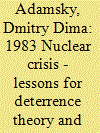

|
|
|
|
|
| Publication |
2013.
|
| Summary/Abstract |
This article distills insights for the scholarship of deterrence by examining the 1983 nuclear crisis - the moment of maximum danger of the late Cold War. Important contributions notwithstanding, our understanding of this episode still has caveats, and a significant pool of theoretical lessons for strategic studies remain to be learned. Utilizing newly available sources, this article suggests an alternative interpretation of Soviet and US conduct. It argues that the then US deterrence strategy almost produced Soviet nuclear overreaction by nearly turning a NATO exercise into a prelude to a preventive Soviet attack. Building on historical findings, this article offers insights about a mechanism for deterrence effectiveness evaluation, recommends establishing a structure responsible for this endeavor, and introduces a new theoretical term to the strategic studies lexicon - a 'culminating point of deterrence'.
|
|
|
|
|
|
|
|
|
|
|
|
|
|
|
|
| 2 |
ID:
171540
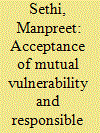

|
|
|
| 3 |
ID:
132781
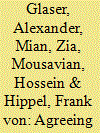

|
|
|
|
|
| Publication |
2014.
|
| Summary/Abstract |
Iran is negotiating with a group of six states over the future of its nuclear program. In November 2013, Iran and the P5+1 (China, France, Germany, Russia, the United Kingdom, and the United States) agreed to a Joint Plan of Action that seeks to reach a "comprehensive solution" by July 20, 2014.
The goal is an agreement on a set of measures that can provide reasonable assurance that Iran's nuclear program will be used only for peaceful purposes and enable the lifting of international sanctions imposed on Iran over the past decade because of proliferation concerns.
A key challenge is to reach agreement on limiting Iran's uranium-enrichment program, which is based on gas centrifuges, in a way that would enable Iran to meet what it sees as its future needs for low-enriched uranium (LEU) fuel for nuclear research and power reactors while forestalling the possibility that this program could be adapted to quickly produce highly enriched uranium at levels and in amounts suitable for use in nuclear weapons
|
|
|
|
|
|
|
|
|
|
|
|
|
|
|
|
| 4 |
ID:
189425
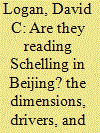

|
|
|
|
|
| Summary/Abstract |
Experts increasingly highlight the dangers of nuclear-conventional entanglement, particularly in the U.S.-China context. This article develops a framework for assessing entanglement and its risks. Applying that framework to China, it finds that Beijing’s missiles are not as entangled as is sometimes feared, but ongoing trends may increase future entanglement. It also presents evidence that, counter to the prevailing wisdom, Chinese entanglement has not emerged as a strategic policy choice but, rather, as the byproduct of more parochial organizational dynamics. Strategic signaling and perception management will be key to controlling escalation risks stemming from nuclear-conventional entanglement in China.
|
|
|
|
|
|
|
|
|
|
|
|
|
|
|
|
| 5 |
ID:
004359
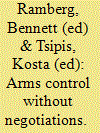

|
|
|
|
|
| Publication |
Cambridge, MIT Press, 1993.
|
| Description |
xv, 210p.
|
| Standard Number |
026213344x
|
|
|
|
|
|
|
|
|
|
|
|
Copies: C:1/I:0,R:0,Q:0
Circulation
| Accession# | Call# | Current Location | Status | Policy | Location |
| 035097 | 327.174/RAM 035097 | Main | On Shelf | General | |
|
|
|
|
| 6 |
ID:
131619
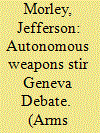

|
|
|
|
|
| Publication |
2014.
|
| Summary/Abstract |
The first multinational conference dedicated exclusively to robotic warfare took place May 13-16 at the UN Office at Geneva as governments around the world confront the emerging technologies that policymakers call "lethal autonomous weapons systems" and headline writers have dubbed "killer robots." The three-day meeting featured diplomats, scholars, and activists debating the implications of new weapons that could automatically target and kill people without human control. Although few such weapons exist now, revolutionary developments in sensors and robotics have stoked fears in some quarters that these weapons systems could make warfare less risky for the attacker and therefore more indiscriminate, but raised hopes in others that they might reduce civilian casualties.
|
|
|
|
|
|
|
|
|
|
|
|
|
|
|
|
| 7 |
ID:
144291
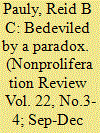

|
|
|
|
|
| Summary/Abstract |
This article explores how two influential American policy makers—Paul Nitze and McGeorge Bundy—wrestled with the idea of a norm against the use of nuclear weapons. Existing scholarship has overlooked how both Bundy and Nitze came to understand the idea of nuclear non-use, especially related to the credibility of threats to use nuclear weapons. Using documentary evidence from their personal papers, this article illuminates the thinking of Bundy and Nitze, finding that both engaged with the idea of a norm of non-use of nuclear weapons in their strategic writing and thought.
|
|
|
|
|
|
|
|
|
|
|
|
|
|
|
|
| 8 |
ID:
053395
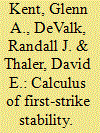

|
|
|
|
|
| Publication |
Santa Monica, Rand Corporation, 1988.
|
| Description |
39p.
|
|
|
|
|
|
|
|
|
|
|
|
Copies: C:1/I:0,R:0,Q:0
Circulation
| Accession# | Call# | Current Location | Status | Policy | Location |
| 030047 | N-2526-AF/KEN 030047 | Main | On Shelf | General | |
|
|
|
|
| 9 |
ID:
129104
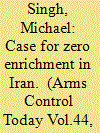

|
|
|
|
|
| Publication |
2014.
|
| Summary/Abstract |
In the debate over sanctions on Iran-their role in bringing Tehran to the negotiating table and their proper place in U.S. diplomatic strategy in the future-scant attention has been paid to a major shift in the negotiating position of the P5+1, the group of six countries (China, France, Germany, Russia, the United Kingdom, and the United States) that is negotiating with Tehran over the Iranian nuclear program. No longer is the P5+1 demanding that Iran halt uranium enrichment. Indeed, in the November 24 first-step nuclear accord, the Joint Plan of Action,[1] the P5+1 all but concedes that Iran will be permitted to enrich in perpetuity. In separate comments that have quickly become conventional wisdom among Iran analysts, U.S. negotiators now characterize their previous position that Iran should halt enrichment as "maximalist."[2] Although undoubtedly expedient, this shift away from a zero-enrichment negotiating position is misguided and unnecessary.[3] The U.S. shift away from zero enrichment to limited enrichment represents a significant diplomatic victory for Iran. For the last decade, the position of the EU-3 (France, Germany, and the UK) and then the P5+1 had been that Iran must "suspend all enrichment-related and reprocessing activities, including research and development." This position was enshrined as an Iranian obligation in a series of UN Security Council resolutions.[4] Iran, however, asserted a "right to enrich" and refused to halt enrichment after resuming it when nuclear talks with the European Union broke down in 2005. This difference formed the core of the confrontation that subsequently developed between Iran and the allies.
|
|
|
|
|
|
|
|
|
|
|
|
|
|
|
|
| 10 |
ID:
185831
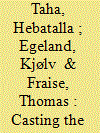

|
|
|
|
|
| Summary/Abstract |
Looming decisions on arms control and strategic weapon procurements in a range of nuclear-armed states are set to shape the international security environment for decades to come. In this context, it is crucial to understand the concepts, theories, and debates that condition nuclear policymaking. This review essay dissects the four editions of The Evolution of Nuclear Strategy, the authoritative intellectual history of its subject. Using this widely acclaimed work as a looking glass into the broader field of nuclear security studies, we interrogate the field's underlying assumptions and question the correspondence between theory and practice in the realm of nuclear policy. The study of nuclear strategy, we maintain, remains largely committed to an interpretive approach that invites analysts to search for universal axioms and to abstract strategic arguments from the precise circumstances of their occurrence. While this approach is useful for analysing the locutionary dimension of strategic debates, it risks obscuring the power structures, vested interests, and illocutionary forces shaping nuclear discourse. In the conclusion, we lay out avenues for future scholarship.
|
|
|
|
|
|
|
|
|
|
|
|
|
|
|
|
| 11 |
ID:
185832
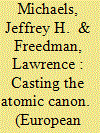

|
|
|
|
|
| Summary/Abstract |
We are grateful to Kjølv Egeland, Thomas Fraise, and Hebatalla Taha for their commentary on the four editions of The Evolution of Nuclear Strategy. In addition to their critique of the book, their review was intended to offer ‘a looking glass into the broader field of nuclear security studies’. Our reply to their review therefore touches both upon their critique, as well as the more general theme of writing about the history of nuclear strategy. Although we disagree with many of their criticisms, and in some instances believe our work was misrepresented, the reviewers have nevertheless made points that deserve serious consideration by ourselves as well as other scholars working in the field. In this reply, we not only defend our work, but also use this as an opportunity to discuss how to approach the past of nuclear strategy, which in turn can allow us to better appreciate the present and future. In the first half of our reply we discuss the reviewers’ more general criticisms of our approach. In the second half we deal with some specific criticisms.
|
|
|
|
|
|
|
|
|
|
|
|
|
|
|
|
| 12 |
ID:
122929
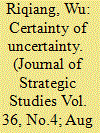

|
|
|
|
|
| Publication |
2013.
|
| Summary/Abstract |
China's nuclear deterrent relies on so-called 'first strike uncertainty', which means not letting the other side be confident of a completely successful disarming strike. But in order to deter, the uncertainty must be high enough. After reviewing the developmental history of China's nuclear capability and the evolution of Chinese and foreign leaders' perceptions of China's nuclear retaliatory capability, this article identifies the criteria of nuclear deterrence for China and other countries. This research can contribute to Sino-US strategic dialogue and deepening understanding of the security consequences of nuclear proliferation.
|
|
|
|
|
|
|
|
|
|
|
|
|
|
|
|
| 13 |
ID:
184888
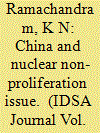

|
|
|
| 14 |
ID:
179448
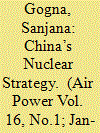

|
|
|
| 15 |
ID:
126249
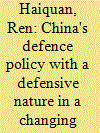

|
|
|
| 16 |
ID:
086249
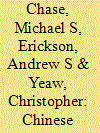

|
|
|
|
|
| Publication |
2009.
|
| Summary/Abstract |
The People's Republic of China (PRC), no longer content with its longstanding 'minimalist' nuclear posture and strategy, is enhancing the striking power and survivability of its theater and strategic missile forces and rethinking its nuclear doctrine in ways that may pose serious challenges for the United States. Although the modernization of Chinese nuclear and missile forces may ultimately result in greater strategic deterrence stability, this change will not come about immediately or automatically. Indeed, it is entirely possible that China's growing missile capabilities could decrease crisis stability under certain circumstances, especially in the event of a US-China conflict over Taiwan.
|
|
|
|
|
|
|
|
|
|
|
|
|
|
|
|
| 17 |
ID:
069213


|
|
|
| 18 |
ID:
063200
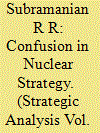

|
|
|
| 19 |
ID:
087069
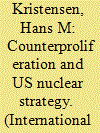

|
|
|
|
|
| Publication |
2008.
|
| Summary/Abstract |
The Bush administration took office with a strong agenda to change and revitalize the US nuclear posture. In a speech to the National Defence University in May 2001, President G. W. Bush said he would change the size of, composition, the character of our nuclear forces in a way to move quickly to reduce nuclear forces.
|
|
|
|
|
|
|
|
|
|
|
|
|
|
|
|
| 20 |
ID:
099707
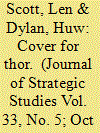

|
|
|
|
|
| Publication |
2010.
|
| Summary/Abstract |
In the late 1950s, as intercontinental ballistic missiles (ICBMs) replaced bombers, the development of Soviet ICBMs prompted fears of strategic vulnerability in the West. The Eisenhower administration's decision to deploy Intermediate Range Ballistic Missiles (IRBMs) on the territory of NATO allies sought to redress the perceived vulnerability until American ICBMs were ready. British deception planners considered how to enhance the threat posed by the IRBMs. An outline plan codenamed 'Celestial' was intended to persuade the Soviets that the otherwise vulnerable missiles could not be readily neutralised. This article explores this deception and how such planning also sought to convey accurate information alongside disinformation. It also suggests that deception planners appear to have given little heed to the potentially counterproductive consequences of such an operation.
|
|
|
|
|
|
|
|
|
|
|
|
|
|
|
|
|
|
|
|
|